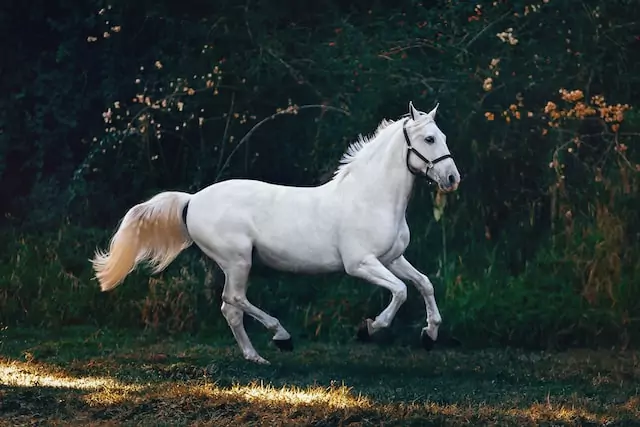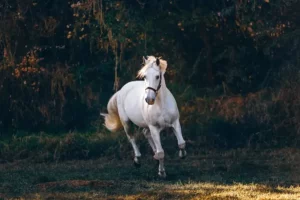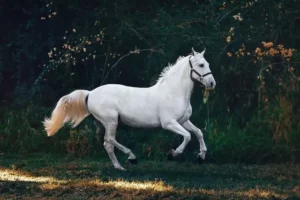0

A white horse is primarily white at birth and remains so throughout its lifetime. A white horse may have brown, blue, or hazel eyes and predominantly pink skin underneath its hair covering. Horses that are “really white,” particularly those with one of the dominant white (W) genes, are uncommon.
The majority of horses who are frequently referred to as “white” are actually “gray” horses, meaning that their hair coats are entirely white. Gray horses can be any hue at birth, and as they age, their hair progressively turns white and takes on a white aspect.
All gray horses, with the exception of those with white birthmarks, have skin that is mostly dark in color. The most popular way for observers to tell adult white and gray horses apart is by their skin tone.

“Shadowfax is that. Not even Theoden, King of Rohan, has ever had a better appearance. He is the leader of the Maeras, lords of all horses. Does he not move as effortlessly as a rapid stream and gleam like silver? — Gandalf
Gandalf rides Shadowfax, a majestic white steed, in The Lord of the Rings. Because of their dazzling coats, which are both attractive and uncommon, white horses have historically been highly treasured in human communities as symbols of wealth and dignity. There are motives behind that.
White horses are notorious for being particularly noticeable in the wild, which makes them prey animals and sensitive to skin cancer. However, they have an unexpected advantage: they reduce horseflies’ attraction to horses.
Anyone who has been unlucky with a horsefly bite, also known as a tabanid, is aware of how much more annoying they are than the typical midge or mosquito. Their mandibles rend and shred flesh, not pierce it. As a result, they can frighten grazing animals and cause pain with their bites.
Additionally, they have the ability to spread dangerous infections like anthrax, parasitic worms, and equine infectious anemia.
Currently, white coats are more resistant to horseflies than darker ones. According to research by Gabor Horvath of Eotvos University in Hungary. Horseflies employ polarized light, or light pulsating on a single plane, to find their next blood meal because they reflect relatively little of it.
Horvath observed two horses—one brown and one white—grazing in a nearby field on a bright June day. Both had to defend themselves against the horseflies, which forced them to move their tails, kick, shudder, swing their heads, bite, lick, and even roll on the group. The brown horse had, on average, 3.7 times more horseflies on or near it than the white horse, according to pictures.
The attacks eventually became so annoying that the horses were forced into a neighboring shaded forest, where they found a brief reprieve. Once more, the brown horse always gave in first and lingered in the shade the longest.
Why did the flies avoid the white horse but like the brown one? It has nothing to do with brightness or color. Horvath discovered that both the brown and the white matte fabric he had hung up were unattractive to horseflies. The flies didn’t begin to gather until he partially covered the brown fabric with a shiny, clear plastic sheet.
Horvath constructed three life-size horse models. One in brown, black, and white, each with a sticky covering to further illustrate this point. He examined the polarized light reflecting off these models using a polarimeter and demonstrated that the more strongly the reflections were present, the more flies clung to the models.
Even the rump and hindquarters of the models, which reflected the most polarized light, attracted the most flies.
According to Horvath, the horsefly’s preference for horizontally polarized light likely serves a variety of purposes. It might direct them to places where they can find water to lay their eggs. Additionally, horseflies are often dark and uninteresting in color, so if they fall on a white body, they might be more noticeable to vultures.

White coats may keep away flies, but it’s obvious that for wild horses, this advantage doesn’t balance the many disadvantages. If not, white horses would be much more prevalent in nature. The zebra and okapi are two examples of grazing animals that have stripes. And all of them have some degree of white banding. Horvath hasn’t overlooked that, and his research closes on an intriguing cliffhanger: “We would like to mention that we are drafting a separate paper on the effect of stripes on host animals like zebra, okapi, etc. to the attractiveness of tabanid flies. We demonstrate how strongly tabanid-repelling such stripes make the host.